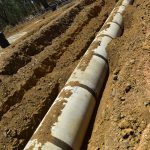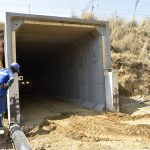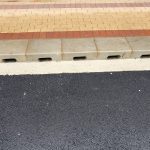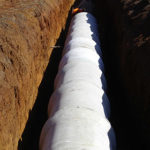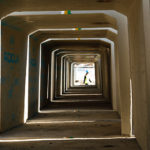Description:
The Rubber Ring Joint Pressure Pipe is a watertight pipe for use in low pressure (2 to 8 Bar) applications.The Spigot and Socket type joint is formed with a widening of the wall of the pipe on the one end. The joint is sealed with a rubber ring.
The Rubber Ring system used compromises a rubber “O” type ring, which is located on the tip of the spigot end of the pipe. When the pipes are joined, the rubber ring is compressed and rolls away from the tip down the barrel. No lubrication is required. The seal is formed between the Socket (or female end) and the outside of the Spigot (or male end). More detail on the joining operation can be found under Handling and installation.
The pipes are supplied in lengths of 2,44m or 1,22m and in T2, T4, T6 and T8 pressure classes, depending on pipe diameter. Special designs can be accommodated.
Custom-made Products:
The pipes are manufactured in 2,44m and 1,22m, but can be manufactured in special lengths to customer specification.
The standard pressure classes for these pipes are T2, T4, T6 and T8. Special intermediate pressures or higher pressures can be designed and manufactured. These are subject to various material constraints, but will be evaluated by our engineers on an ad hoc basis.
Please contact your nearest Rocla branch for details on these products or utilize the contact us facility.
Accessories:
Rubber Collars
Rubber Collars can be supplied in order to improve the watertightness of the pipe-line. Your nearest Rocla branch can supply pricing on these.
Manholes
For Valve chambers, Precast Concrete Manholes can be used to provide the necessary access for maintenance, inspection, etc.
The Precast Concrete Manholes are also manufactured by Rocla. See Manholes.
Areas of Use:
Rubber Ring Joint Pressure pipes are used primarily in the transportation of bulk water supply and irrigation applications.
They are ideal in applications where maintenance-free, high quality solutions are required.
Handling and Installation:
When handling any concrete products, it is important to remember that, as concrete is a heavy and somewhat brittle material, bumps or shock loads of any description are liable to damage the product. This applies particularly to sharp edges.
When offloading the products on site, the equipment must not damage the products. Sewer pipes do not have a lifting hole, as the system must be watertight. A 150mm sling passing around the center of gravity of the pipe must be used to handle the product. When placing the product on the ground, it is important to note that the pipe must not rest on the socket portion. The full weight of the pipe must be borne by the barrel of the pipe.
During the installation, the trench or excavation must be prepared to the Site Engineers specification. Once the bedding is in place it is ready for the pipes. The specific area where the socket end would rest must be removed, so that the pipe can be horizontal during installation, and that the pipe can rest on the barrel once in place.
Each pipe must be sealed with a rubber ring. This must be place on the spigot end and located in the correct position as indicated by the locating groove. The rubber ring must be of equal tension around the barrel. This can be attained by inserting a screwdriver, or similar object, between the ring and the pipe, and running the screwdriver around the barrel twice.
The pipes are lowered into place using the same handling technique as before. Once the pipes are lined up, it will be necessary to pull the spigot end into position to fit into the socket end of the already laid pipe whilst the pipe is still suspended. This can either be done by levering the pipe forward, or by means of a tirfor system, which pulls the pipes together.
Once this is completed, and the pipe is correctly sealed, the pipe can be released to lie on the bedding. It must be noted that again, the full weight of the pipe must rest on the barrel only and not on the socket area. The next pipe can then be lowered into position.
Backfilling of the pipe to the engineer’s specification is of utmost importance, as the pipe strength is designed to suit the installed condition. Care must be taken to compact underneath the pipe curvature to ensure a good foundation is in place. For more information on pipe installation, please use the contact us facility, as our staff can be of assistance on site with the installation activities.


